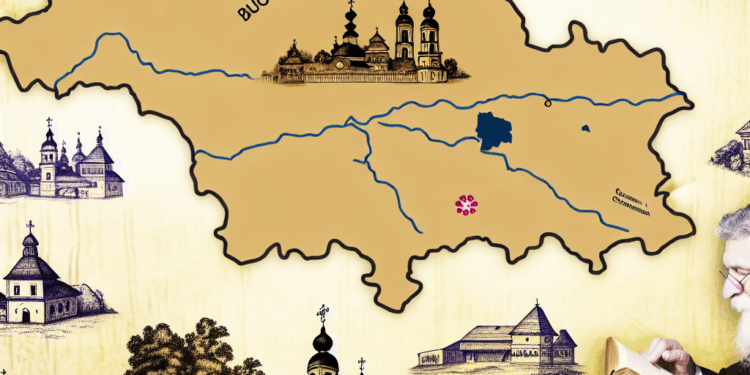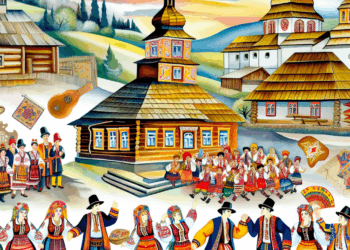Bukovina is a historical region in Eastern Europe, which has been part of different states and cultures in different periods of its existence. Over the centuries, this area has undergone many changes, leaving behind a confusing and diverse trail of historical legacy. In this article, we will look at a few little-known but significant historical facts about Bukovina, covering both princely times and more modern eras.
I. Princely times
Bases of formation of independence
At the turn of the XII-XIII centuries, the territory of Bukovina was inhabited by Belarusian tribes and was under the control of various principalities. One of the first significant facts is the foundation of the principality of Galicia, established in the XII century. In 1190, the first settlement was founded within the borders of modern Chernivtsi, which over time grew into an important cultural and economic centre.
Mamai Valley
In the XIII century in the south-east of Bukovina there was the Valley of Mamai, a place where major battles between Russian and Turkic tribes took place. This historical fact testifies to the strategic importance of the region, as well as the diversity of its population. Battles between different ethnic groups became the basis for the formation of a unique cultural landscape.
Prince Alexander III
At the end of the 14th century, Prince Alexandru III, the ruler of Moldavia, united the territory of Bukovina with Moldavia, which contributed to its political and economic integration. In the 1400s, he established a system of local self-government that allowed for the development of agriculture and the support of crafts, which was a significant step for the region.
II. Times of the Austrian Empire
Accession to the Austrian Empire
In 1774, after the Polish partitions, the territory of Bukovina was ceded to the Austrian Empire as a result of the Russo-Turkish war. This was a turning point in the history of the region. The hope for economic growth and educational development led to increased migration of various ethnic groups, including Ukrainians, Romanians and Germans.
The emergence of universities
In 1875, Chernivtsi University was founded in Chernivtsi and became an important cultural centre. It was the first university in Ukraine to teach in three languages: German, Ukrainian and Romanian. Many famous scientists and cultural figures, such as Ivan Franko and Paraska Petrichenko, later took part in its activities.
Cultural diversity
The time of Austrian rule was an era of intercultural interaction. Bukovina became a place of concentration of different languages and traditions, which in turn contributed to the emergence of a unique artistic style that combined elements of different cultures. Places for communication and cultural exchange, such as social clubs and theatres, became favourite centres for the local population.
III. The inter-war years
Formation of the Kingdom of Romania
After World War I, Bukovina became part of the Kingdom of Romania in 1918. This transition was significant for both the cultural and political life of the region. One of the most significant events was the establishment of the Romanian Academy of Sciences in 1921, which was actively engaged in research in the fields of history, ethnography and culture.
The impact of economic conditions
The interwar years were not easy for the inhabitants of Bukovina due to economic instability. In the 1930s, the devastating effects of the Great Depression affected many regions, including Bukovina. During this time, there was an increase in migration as many people sought better living conditions in cities such as Chernivtsi and Suceava. This migration influenced the urban structure and brought diversity to the economic life of the region.
Schools and education
The education system underwent improvements at this time: new schools began to open and local people took an active interest in cultural development. In 1925, the first Yiddish school for Jewish children was founded. Education became available to people of different nationalities, which strengthened cultural exchange.
IV. The Soviet era
Incorporation into the USSR
In 1940, as a result of World War II, Bukovina was annexed to the Soviet Union. This event led to significant changes in both the political and cultural life of the region. After the annexation, a policy of Russification began, which affected many aspects of the life of the local population.
Collectivisation and its consequences
The 1950s was the time of mass collectivisation, which affected Bukovina’s agriculture. Many peasants were forced to join collective farms, which caused discontent among the local population. However, at the same time, the modernisation of rural production took place, contributing to the growth of the economy.
Cultural changes
In the 1960s and 1970s, Bukovina became a place for the development of various cultural movements. A number of theatres and art galleries were opened during this time, which helped to strengthen the cultural identity of the region. Local artists and writers, such as Dmytro Pavlyuk, began to organise themselves into creative groups, promoting cultural exchange and development.
Legacy of the Soviet period
The Soviet era left an important mark on Bukovina’s architecture and urban planning. Many buildings constructed during this period, including residential complexes and cultural centres, have become a significant part of the region’s urban identity. After the collapse of the Soviet Union, in 1991, Bukovyna became part of independent Ukraine again, continuing to develop its cultural heritage.
V. Conclusion
The history of Bukovyna is full of many events and influences from different cultures, which has created a unique identity for the region. From princely times to our time, the territory continues to be an important cultural and historical centre. Understanding its past events helps to better understand the current state and future of this multi-ethnic region.
Bukovina is a living mosaic of tradition and influence, the creation of new culture and the preservation of ethnic characteristics. Its history is the history of the people who inhabited this land and their aspirations for harmony and development.








